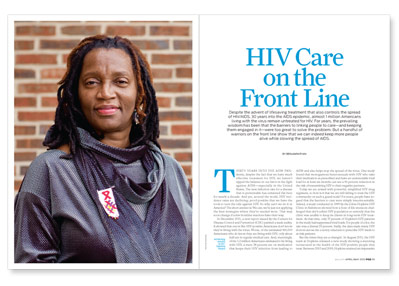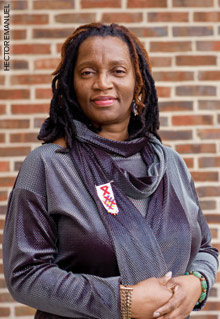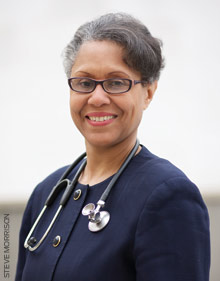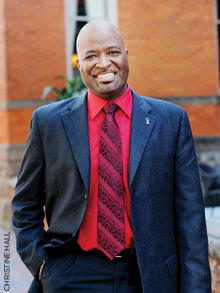
Thirty years into the AIDS Pandemic, despite the fact that we have much effective treatment for HIV, we haven’t tipped the balance in our favor in the fight against AIDS—especially in the United States. The new infection rate for a disease that is preventable has remained flat here for nearly a decade. And yet, around the world, HIV incidence rates are declining: proof positive that we have the tools to turn the tide against HIV. So why can’t we do it in America? The short answer is: We can, we’re just not applying the best strategies where they’re needed most. That may soon change if a few frontline warriors have their way.
In December 2011, a new report issued by the Centers for Disease Control and Prevention (CDC) painted a stark reality. It showed that one in five HIV-positive Americans don’t know they’re living with the virus. Worse, of the estimated 960,000 Americans who do know they are living with HIV, only about half are in regular medical care. And, stunningly, of the 1.2 million Americans estimated to be living with HIV, a mere 28 percent are on medication that keeps their HIV infection from leading to AIDS and also helps stop the spread of the virus. One study found that monogamous heterosexuals with HIV who take their medication as prescribed and have an undetectable viral load for at least six months can see a 96 percent reduction in the risk of transmitting HIV to their negative partners.
Today we are armed with powerful, simplified HIV drug regimens, so how is it that we are still failing to treat the HIV community on such a grand scale? For years, people have argued that the barriers to care were simply insurmountable. Indeed, a study conducted in 1999 by the Johns Hopkins HIV Clinic in Baltimore showed how a host of life stressors challenged that city’s urban HIV population so severely that the clinic was unable to keep its clients in long-term HIV treatment. At that time, only 37 percent of Hopkins’s HIV patients in the study had suppressed viral loads. For people of color, the rate was a dismal 25 percent. Sadly, the data made many HIV doctors across the country reluctant to prescribe HIV meds to at-risk patients.
But the times they are a-changin’. In August 2011, the HIV team at Hopkins released a new study showing a stunning turnaround in the health of the HIV-positive people they treat. Between 2003 and 2009, Hopkins retained an impressive 94 percent of its clients—a population that has grown older and included more women and heterosexuals—in care. By 2010, 84 percent of the HIV clients at Hopkins had a fully suppressed viral load. The results proved that new approaches could lead to a new era of access to care for people living with HIV, and that HIV providers can help even the most high-risk populations be effectively treated with HIV therapy. (A third of Hopkins’s clients self-reported injection drug use.)
“Antiretroviral Therapy: Now ‘It Just Works’” is the title of an editorial commentary on the Hopkins results written by Paul Sax, MD, clinical director of the HIV program at Brigham and Women’s Hospital in Boston, and published in the September 2011 issue of Clinical Infectious Diseases. It has become a motto for many who previously abandoned hope for the health of their patients.
In the shadow of the CDC’s scary stats from last year, the recent success at Johns Hopkins has led the CDC to issue a rallying call to solve the problem. The federal agency asked public health officials and HIV providers to follow a key element of the Obama administration’s National HIV/AIDS Strategy: namely, to improve patient engagement at every step along the continuum of care, starting with a positive HIV test, through immediate linkage to care and commencement of treatment, and including retention in care for the long term.
The Hopkins results suggested that the key to connecting people to—and keeping them in—care is overcoming the constellation of risk factors that affect wide swaths of the HIV population: homelessness, substance abuse, stigma, poverty, lack of transportation, lack of medical coverage, fear or mistrust of the medical system and impatience with red tape and bureaucratic hassles.
Any one of these can cause people to miss their appointments. A missed appointment is the time when HIV providers and social service agencies need to be on high alert for ways to re-engage patients and to work with them to address and resolve those barriers to care. Indeed, doing so involves a lot of hard work and a commitment to getting results.
Richard Moore, MD, director of the Johns Hopkins Hospital HIV Clinic and coauthor of the new study, breaks it down. His team has succeeded against all odds, he says, by providing a kind of home away from home for people living with HIV. Primary care and all kinds of specialty care are provided under one roof. Using an electronic records system in place for two decades to keep tabs on every patient, medical providers work with a team of social workers and other support staff to make sure people don’t fall through the cracks.
“If a patient misses a couple of appointments in a row, you wonder if there’s something interfering in their life that’s making it hard for them to come in, or maybe they’re fatiguing in regard to care,” Moore says. “Knowing that patient may be having problems and giving them a call, routing them to see a case worker or something of that sort is one way we use our system to try to troubleshoot before an issue gets out of hand.”
The Hopkins group is also always looking for ways to integrate new HIV treatment guidelines into its practice. And thanks to the electronic records system, it’s easier for providers to monitor the effectiveness of new medical approaches and protocols and to measure their success.
Kaiser Permanente is another group that has been highly effective at engaging and keeping people in its HIV program; 95 percent of the national network’s HIV-positive clients have suppressed viral loads. Eager to export Kaiser’s model and share the lessons his team learned from years of experience treating people with HIV, Michael Horberg, MD, the program’s director, challenges other HIV providers to improve patient retention and care. Kaiser can enter aggregate patient information into a database, allowing Kaiser to compare treatment achievements among HIV providers across the country. Horberg’s division offers free mentorship to other health care providers nationwide and presents tools and information on its website, kp.org/hivchallenge.
Meanwhile, the National Quality Center, NQC, an initiative of the New York State Department of Health, has also created a program to export proven care models across the country. Currently, it is working with 400 U.S. HIV providers who serve over 400,000 positive people. Encouraging retention in care is a central goal. NationalQualityCenter.org, the group’s website, presents a clearinghouse of information for HIV care providers. The center also offers opportunities for mentorship from academic researchers and other coaches.
Is sharing best practices enough, or do we need structural shifts in health care to get more of these hundreds of thousands of untreated people with HIV into care—and test those who still don’t know they have HIV?
“Mentoring is a great idea,” says Moore, adding that his Johns Hopkins clinic has also hosted visiting HIV providers from around the world for mentorship sessions. “Inasmuch as a practice that may not have the resources can get tips about maintaining retention or keeping up to date with guidelines, that’s fine. But our rather fragmented health care system doesn’t support that very well at the moment. I’m hoping that some of the changes taking place over the next two years will help support that. I don’t think that there are easy solutions here.”
While Hopkins produced the evidence that the right techniques work to connect people to and keep them in care, and Kaiser Permanente and the NQC will do their best to help roll out best practices, the best role models remain those organizations (some large and well-funded, some small and struggling) that learn new techniques every day as they fight HIV in some of the most challenging arenas. Often, what distinguishes their work is the ability to provide the critical personal touches that make the difference when it comes to getting people with HIV committed to long-term care. POZ asked representatives of three such groups what works—and why.  Sabrina Heard: The Women’s Collective
Sabrina Heard: The Women’s Collective
Sabrina Heard fights HIV with her personal experience. A recovered addict who’s been living with HIV for more than two decades, Heard emerged from years of denial and learned how to care for herself with the help of the Women’s Collective, a small social services agency for women with HIV in Washington, DC. Now, as a community health worker at the group, she spends her days on the front lines, making sure her sisters in the HIV community don’t fall into isolation and neglect the way she once did.
Heard’s persistence and fierce drive to connect with her clients ensure that the women in her charge are fully integrated into HIV care. As soon as a red flag appears—if a woman hasn’t gotten her labs done or visited an HIV specialist within six months, for example—Heard takes action.
“We make a lot of phone calls,” she says.
Once she reaches a woman who is at risk for dropping out of care, Heard investigates and finds solutions for the full scope of that woman’s personal needs, concerns and barriers to care. It’s vital to do so, she says.
“If a person is competing for their basic needs, they’re going to be concentrating on trying to get some food, making it to the food bank, making it to their housing appointments and things like that, as opposed to making it to their medical appointments,” Heard says.
The agency’s ongoing relationship with each client allows the providers to make any necessary phone calls on behalf of their clients, preventing, say, the chance that the frustration of being on hold with a doctor’s office will lead a woman to throw in the towel. They often send a staff member to accompany a woman to her appointments, helping her communicate better with her doctor.
“If you’re not a person who’s knowledgeable on the specifics of what the doctor’s talking about, honey, all that just sounds like a foreign language,” Heard says. “So we try to help explain what the doctor’s saying.”
Heard also allows the already intimate relationships with her clients to get even more personal.
“I share my story,” she says. “I don’t mind sharing my experience in different realms with my clients in an effort to encourage them. I let them know how I made it through that particular barrier.” L. Jeannine Bookhardt-Murray, MD: Harlem United
L. Jeannine Bookhardt-Murray, MD: Harlem United
A community health center for indigent people with HIV, Harlem United is located in the upper reaches of Manhattan. The agency finds the key to its good track record within the notion of community. With a budget of nearly $40 million and various divisions that provide a panoply of services—including testing, HIV treatment, dental care, counseling, case management and adult day programs—Harlem United has found it takes a village to keep people in care.
Once people are tested, Harlem United ensures that they are seen by one of the nonprofit’s HIV doctors the very same day. Someone from the testing division will even walk newly diagnosed people to the clinic, a few blocks away.
“That first visit is crucial,” says chief medical officer L. Jeannine Bookhardt-Murray, MD. “If people do not see a provider on the same day [they receive their HIV diagnosis], we know from the get-go that we’re going to have trouble getting them into care and keeping them there. The typical patient will just go underground and maybe resurface in a year or so, or when they’re sick.”
Harlem United employs an approach based on teamwork—literally. A newly diagnosed person is assigned a group of staffers to assist him or her with administrative hassles and provide information about living with HIV. Then each client is assigned a long-term case manager who will make sure medical and service appointments are kept, help address problems that may arise, and provide placement in the agency’s support groups.
This team-based system, called the Linkage to Care program, has worked. In 2010, only 29 percent of either walk-ins or clients referred to Harlem United through another agency were retained in care, while 68 percent of those entering through the Linkage to Care program were retained. By 2011, that figure had increased to 89 percent.
Ultimately, Harlem United brings clients into the embrace of a large family of people, all looking out for their well-being.
“There is such a personalized touch,” Bookhardt-Murray says. “For example, it might be the janitor who knows where this person hangs out in the daytime, and if we’ve lost the person, the janitor will let us know.” Mark Douglas: My Brothaz HOME
Mark Douglas: My Brothaz HOME
Too often, while the road to success is clear, it is hardly paved with gold. My Brothaz HOME in Savannah, Georgia, is one of the many struggling HIV services agencies dedicated to reaching people outside major urban areas. Since 2000, the group has provided rapid HIV-antibody testing (testing more than 1,200 people last year) and developed a proven system to link new HIV cases into care. It also offered peer support, advocacy, treatment education and HIV prevention—all with a budget of less than $140,000. As we go to press, the group has learned it must close its doors, a victim of the economy.
Mark Douglas, the passionate cofounder and executive director of My Brothaz, says the minute they told someone he or she was HIV positive—24 people last year—the group would begin the process of linking that person into care. The first appointment with an HIV specialist was made on the spot. And since My Brothaz knew from experience that people who lack insurance tend to delay treatment, the group helped uncover possible sources of health coverage for new cases—usually a combination of funding from Medicaid and AIDS Drugs Assistance Programs, as well as pharmaceutical co-pay programs, since most clients earned less than $10,000 per year.
“Everything would be done for them before they walked out the door,” Douglas says, describing My Brothaz’s efforts to make sure people get connected to health care and services after an HIV diagnosis. “So even after they’d left, we would follow up, calling to make sure that they went to the appointment. And if necessary we would take them to the appointment.”
The most important ingredient in the group’s 98 percent success rate in linking people into care, Douglas says, was gaining his clients’ trust.
“The relationship, the rapport you develop with a client, comes over a period of time. We’ve been here in the community for 12 years,” he says. “We’ve made them feel at home. Even at the time of learning their HIV status, they still felt supported, loved, valued, important.” And that, it seems, is the winning strategy behind every frontline warriors’ success.






Comments
Comments